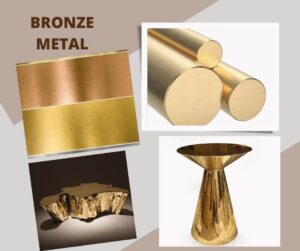Bronze: An Overview of the Types and Composition of this Versatile Alloy
Bronze: A Versatile and Timeless Alloy
Bronze is an alloy composed of copper and tin, although other metals such as aluminum, nickel, or zinc can also be added to achieve specific characteristics. The resulting metal has been widely used throughout history for its unique properties and versatility.
History of Bronze
Bronze is one of the oldest alloys known to humanity, dating back to the Bronze Age, which lasted from around 3200 BC to 600 BC. The Bronze Age was characterized by the widespread use of bronze tools, weapons, and decorative objects. Bronze replaced stone and copper as the preferred material for tools and weapons because it is stronger and more durable than these materials.
Uses of Bronze
Bronze has a wide range of applications due to its unique properties. It is a hard, strong, and ductile metal that is also resistant to corrosion. These characteristics make bronze an ideal material for many applications, including:
- Sculptures: Bronze is a popular material for sculptures because it is malleable and can be cast in intricate shapes. The famous statue of David by Michelangelo was cast in bronze, for example.
- Decorative objects: Bronze has been used to create decorative objects such as vases, lamps, and candlesticks. The metal’s unique color and finish make it an ideal choice for ornamental objects.
- Musical instruments: Many musical instruments, such as cymbals, bells, and gongs, are made of bronze due to its resonance and durability.
- Coins: Bronze has been used for coins throughout history. The Chinese were the first to use bronze coins, and they were widely used in Europe until the 18th century.
- Industrial applications: Bronze is used in many industrial applications, including bearings, gears, and valves, due to its hardness and resistance to corrosion.
 Types of Bronze
Types of Bronze
There are many different types of bronze, each with its own unique characteristics. Some of the most common types of bronze include:
- Phosphor bronze: This type of bronze contains small amounts of phosphorus, which gives it increased strength and corrosion resistance.
- Aluminum bronze: This type of bronze contains aluminum, which gives it increased strength and resistance to corrosion.
- Silicon bronze: This type of bronze contains silicon, which gives it increased strength and resistance to corrosion. It is commonly used in marine applications.
- Manganese bronze: This type of bronze contains manganese, which gives it increased strength and resistance to wear.
- Nickel bronze: This type of bronze contains nickel, which gives it increased strength and resistance to corrosion.
here’s a chart outlining the most common types of bronze and their composition:
| Type of Bronze | Composition |
|---|---|
| Phosphor Bronze | Copper (Cu) 95.0-97.5%, Tin (Sn) 2.0-5.0%, Phosphorus (P) 0.01-0.35% |
| Aluminum Bronze | Copper (Cu) 88.0-94.0%, Aluminum (Al) 4.0-11.0%, Iron (Fe) 0.5-5.0%, Nickel (Ni) 0.5-5.0%, Manganese (Mn) 0.5-4.0% |
| Silicon Bronze | Copper (Cu) 96.0-98.0%, Silicon (Si) 1.5-3.0%, Manganese (Mn) 0.5-1.2% |
| Manganese Bronze | Copper (Cu) 55.0-60.0%, Zinc (Zn) 39.0-44.0%, Aluminum (Al) 0.25-1.5%, Iron (Fe) 0.2-2.0%, Manganese (Mn) 0.25-2.0% |
| Nickel Bronze | Copper (Cu) 60.0-66.0%, Nickel (Ni) 20.0-30.0%, Zinc (Zn) 2.5-6.0%, Lead (Pb) 0.05-0.20%, Iron (Fe) 0.10-1.0% |
Conclusion
Bronze is a versatile and timeless alloy that has been used throughout history for its unique properties. It is a hard, strong, and ductile metal that is also resistant to corrosion, making it ideal for many applications. Bronze is used in sculpture, decorative objects, musical instruments, coins, and industrial applications. There are many different types of bronze, each with its own unique characteristics. Bronze remains an important metal in modern times, and it is likely to continue to be used for many years to come.
Comments are closed.